Search
- Page Path
-
- HOME
- Search
- Review Article
- Metabolic complications of obesity in children and adolescents
- Hyunjin Park, Jung Eun Choi, Seunghee Jun, Hyelim Lee, Hae Soon Kim, Hye Ah Lee, Hyesook Park
-
The global prevalence of childhood and adolescent obesity, exacerbated by the COVID-19 pandemic, is affecting not only school-aged children but also preschoolers. Early-onset obesity, along with a higher risk of metabolic complications, may contribute to a lower age of onset of cardiovascular disease (CVD). As metabolic diseases such as diabetes, dyslipidemia, and non-alcoholic fatty liver disease (NAFLD) observed in adulthood... -
DOI: https://doi.org/10.3345/cep.2023.00892 [Accepted]
- Nephrology (Genitourinary)
- Kidney complications associated with COVID-19 infection and vaccination in children and adolescents: a brief review
- Hee Sun Baek, Min Hyun Cho
- Clin Exp Pediatr. 2023;66(10):424-431. Published online June 28, 2023
-
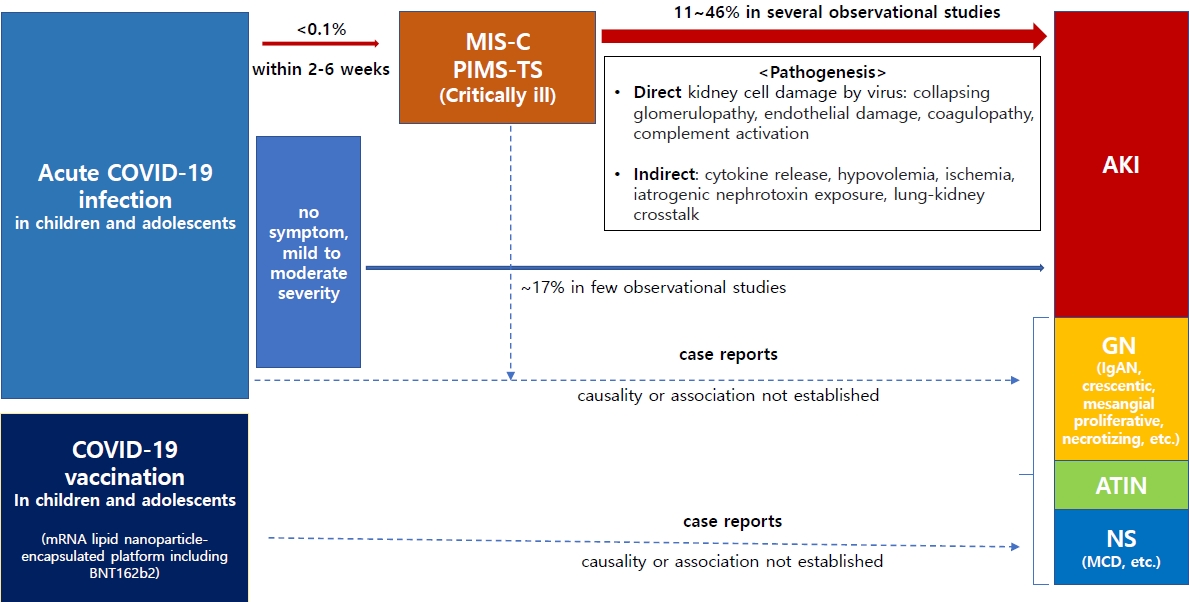
Several observational studies have shown that acute kidney injury affects up to 46% of children and adolescents who develop severe postinflammatory responses, such as multisystem inflammatory syndrome in childhood, due to coronavirus disease 2019 (COVID-19). Although causality has not been established, some cases of glomerulopathy or nephrotic syndrome occurring after COVID-19 infection or vaccination have been reported. Therefore, kidney complications associated with these conditions in children and adolescents warrant attention.
- Pulmonology
- Long COVID in children and adolescents: prevalence, clinical manifestations, and management strategies
- Eun Kyo Ha, Ju Hee Kim, Man Yong Han
- Clin Exp Pediatr. 2023;66(11):465-474. Published online June 19, 2023
-

· Current definitions of long coronavirus disease (COVID) in children and adolescents vary in duration, ranging from 4 to 12 weeks or more.
· The clinical spectrum of long COVID in children and adolescents comprises a wide range of symptoms and might be a multisystem disorder.
· Persistent health problems with a prevalence of 1%–66.5% were reported in children and adolescents after COVID-19, with a higher incidence of persistent single or multiple symptoms.
- Original Article
- Gastroenterology
- Relationship between nonalcoholic fatty liver disease and hyperandrogenemia in adolescents with polycystic ovary syndrome
- Ozlem Kara, Hanife Aysegul Arsoy, Murat Keskin
- Clin Exp Pediatr. 2023;66(9):395-402. Published online June 14, 2023
-

Question: Is polycystic ovary syndrome (PCOS) a risk factor for nonalcoholic fatty liver disease (NAFLD) in adolescents?
Finding: The frequency of NAFLD did not increase in adolescents with PCOS. However, hyperandrogenemia was a risk factor for NAFLD.
Meaning: Adolescents with PCOS and hyperandrogenemia should be closely monitored for hepatic steatosis.
- Review Article
- Infection
- Etiological and pathophysiological enigmas of severe coronavirus disease 2019, multisystem inflammatory syndrome in children, and Kawasaki disease
- Jung-Woo Rhim, Jin-Han Kang, Kyung-Yil Lee
- Clin Exp Pediatr. 2022;65(4):153-166. Published online November 23, 2021
-
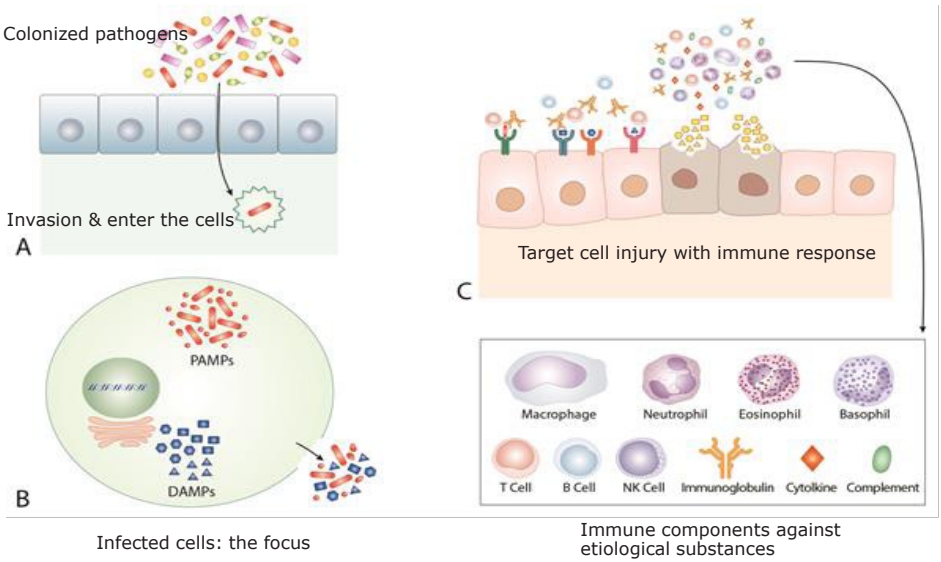
· Severe cases of coronavirus disease, Kawasaki disease (KD), and multisystem inflammatory syndrome in children (MIS-C) share similar findings: a protracted clinical course, multiorgan involvement, and similar activated biomarkers.
· Here we propose etiological agents in KD and MIS-C as species in the microbiota and introduce a common pathogenesis through the protein-homeostasis-system hypothesis.
· Early proper dose of corticosteroids and/or intravenous immunoglobulin may help to reduce morbidity and mortality in these diseases.
- Original Article
- Endocrinology
- Effects of probiotics combined with dietary and lifestyle modification on clinical, biochemical, and radiological parameters in obese children with nonalcoholic fatty liver disease/nonalcoholic steatohepatitis: a randomized clinical trial
- Thushara Rodrigo, Samaranayake Dulani, Sumudu Nimali Seneviratne, Arjuna P. De Silva, Jerad Fernando, H. Janaka De Silva, Jayasekera , V. Pujitha Wickramasinghe
- Clin Exp Pediatr. 2022;65(6):304-311. Published online November 11, 2021
-
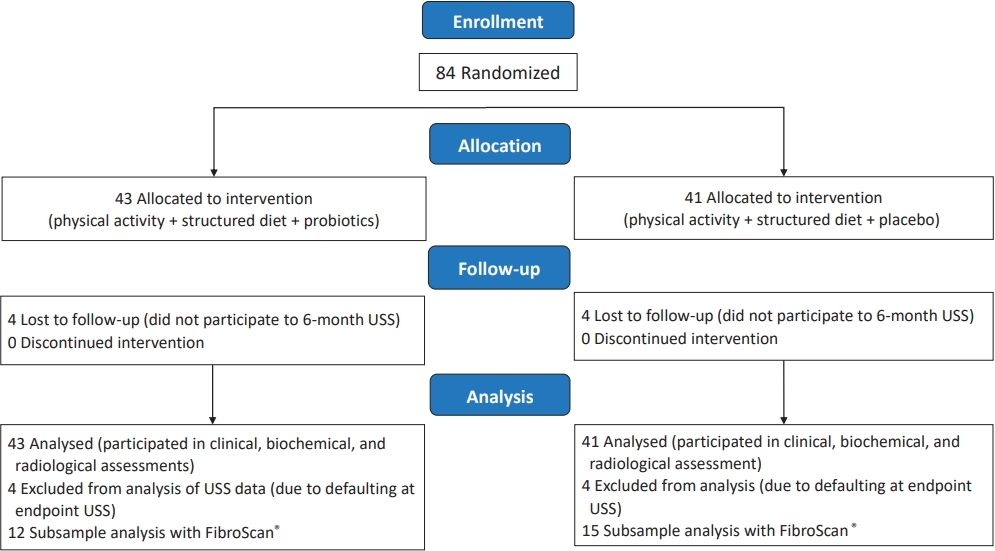
Question: Could probiotics be used as a therapeutic modality in nonalcoholic fatty liver disease/nonalcoholic steatohepatitis?
Finding: There seem no added advantages over lifestyle modifications compared to Probiotics.
Meaning: There does not seem to be an advantage of probiotics over lifestyle modifications in improving obesity-associated metabolic derangement in children.
- Other
- Clinical spectrum and short-term outcomes of multisystem inflammatory syndrome in children in a south Indian hospital
- Muruganantham Balagurunathan, Thrilok Natarajan, Jothilakshmi Karthikeyan, Venkateshwaran Palanisamy
- Clin Exp Pediatr. 2021;64(10):531-537. Published online August 4, 2021
-
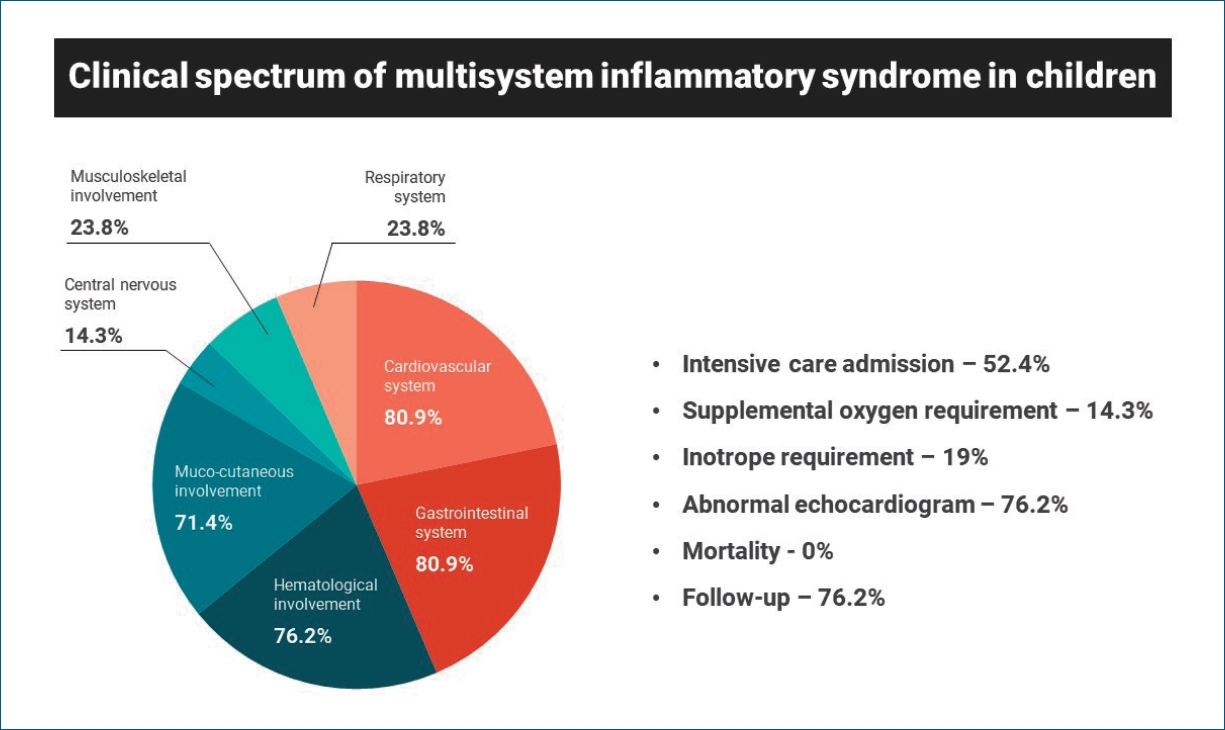
Question: What are the clinical spectrum, course, and short-term outcomes of multisystem inflammatory syndrome in children (MIS-C)?
Finding: MIS-C can have variable clinical manifestations. Fever is most common, followed by gastrointestinal and cardiovascular symptoms. Early identification and appropriate management lead to favorable outcomes.
Meaning: MIS-C can present in a myriad of ways and severities. High suspicion is necessary to ensure its early identification and appropriate management and favorable patient outcomes.
- Neonatology (Perinatology)
- Comparison of minimally invasive surfactant therapy with intubation surfactant administration and extubation for treating preterm infants with respiratory distress syndrome: a randomized clinical trial
- Mohammad Kazem Sabzehei, Behnaz Basiri, Maryam Shokouhi, Sajad Ghahremani, Ali Moradi
- Clin Exp Pediatr. 2022;65(4):188-193. Published online July 28, 2021
-
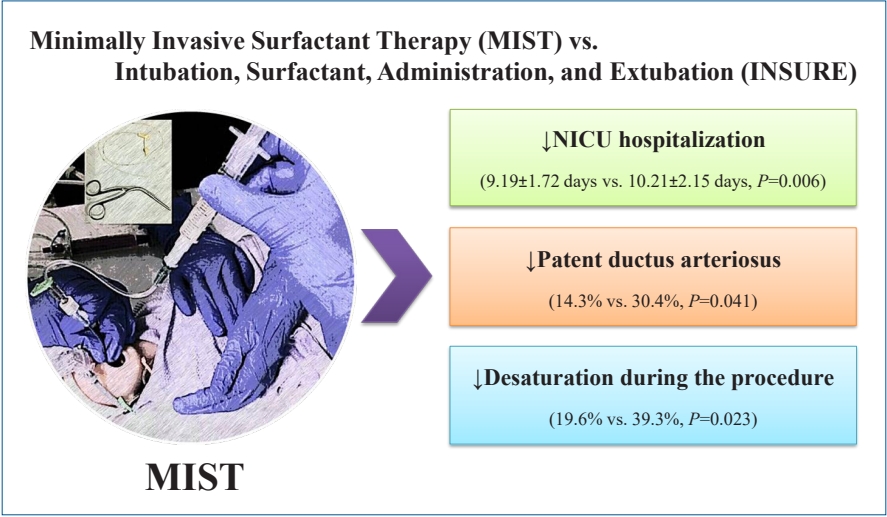
Question: Are the short-term outcomes of minimally invasive surfactant therapy (MIST) relatively superior to those of INtubation, SURfactant administration, and Extubation (INSURE) in preterm infants with respiratory distress syndrome (RDS)?
Finding: MIST could be an appropriate substitution for INSURE in preterm infants with RDS since it reduced hospitalization time and number of side effects.
Meaning: MIST is recommended for surfactant administration for its proven advantages over the INSURE technique.
- Review Article
- Hematology
- Thrombosis and severe acute respiratory syndrome coronavirus 2 vaccines: vaccine-induced immune thrombotic thrombocytopenia
- Young Shil Park
- Clin Exp Pediatr. 2021;64(8):400-405. Published online June 30, 2021
-
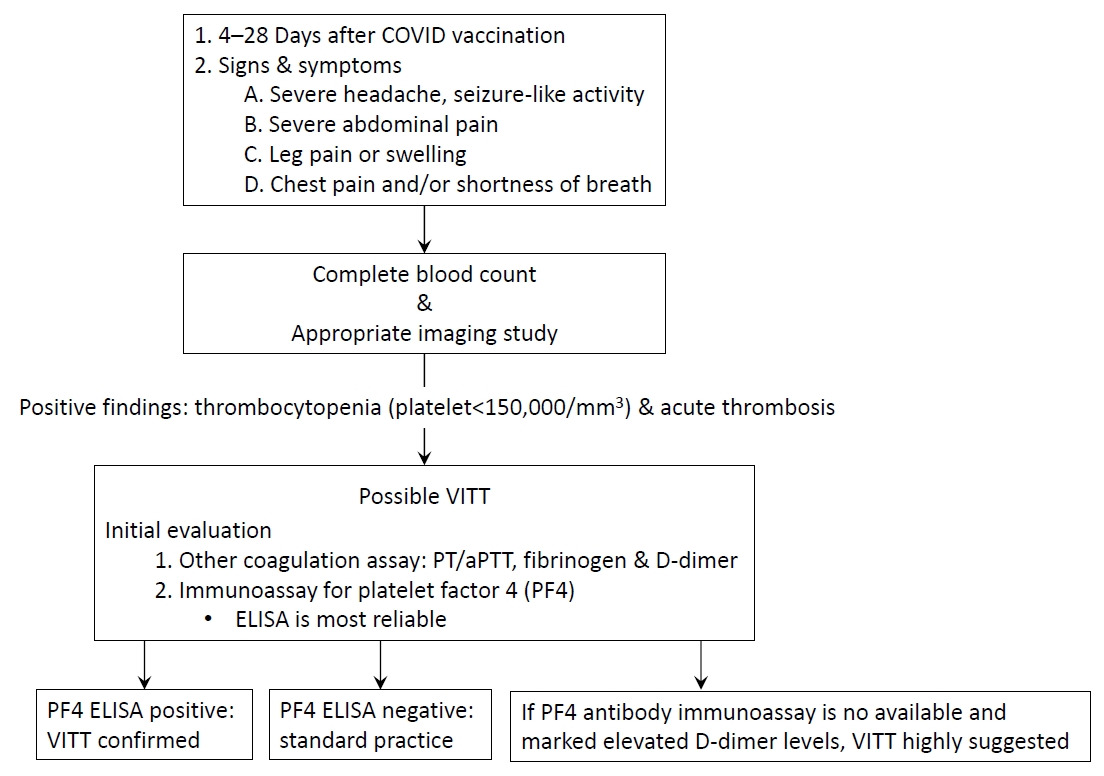
· Thrombosis and thrombocytopenia occurring within 4–28 days after severe acute respiratory syndrome coronavirus 2 vaccination require attention.
· The terms vaccine-induced immune thrombotic thrombocytopenia (VITT) and thrombosis with thrombocytopenia syndrome (TTS) are used.
· VITT is pathogenetically similar to heparin-induced thrombocytopenia.
· VITT/TTS could be associated with the development of platelet-activating anti-platelet factor 4 antibodies.
· For suspected VITT/TTS, early treatment decisions (intravenous immunoglobulin, non-heparin anticoagulant, and avoidance of platelet transfusions) are important.
- Original Article
- General Pediatrics
- Gross motor dysfunction and balance impairments in children and adolescents with Down syndrome: a systematic review
- Preyal D. Jain, Akshatha Nayak, Shreekanth D. Karnad, Kaiorisa N. Doctor
- Clin Exp Pediatr. 2022;65(3):142-149. Published online June 11, 2021
-
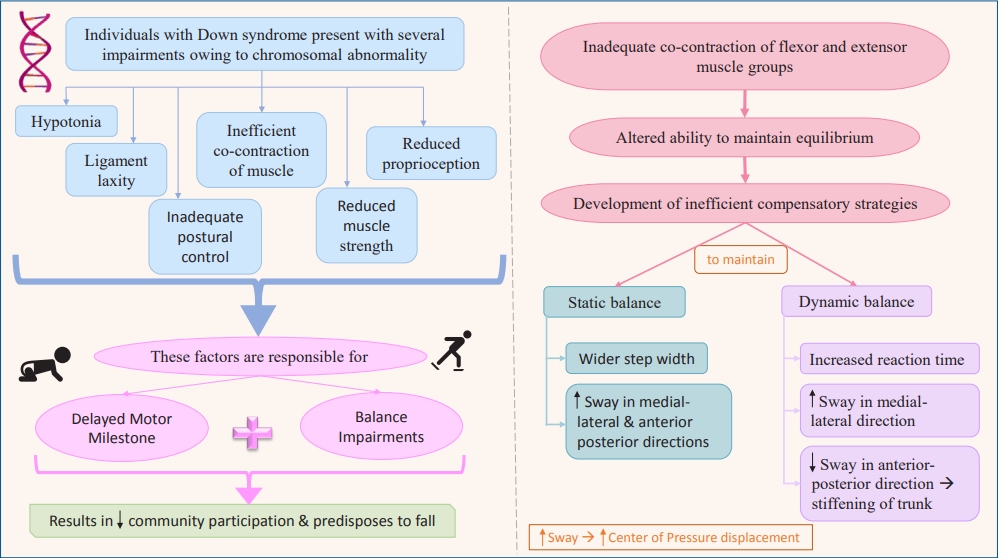
Question: What are the primary motor and balance dysfunctions in children with Down syndrome?
Finding: These individuals have gross delays, altered balance, and inefficient compensatory mechanisms.
Meaning: Neuromuscular and musculoskeletal impairments due to the chromosomal abnormality lead to developmental delay. These children also exhibit poor balance with greater instability and inefficient compensatory mechanisms including altered center of pressure displacement and trunk stiffening that predisposes them to falls.
- Endocrinology
- Association between polycystic ovary syndrome and risk of attention-deficit/hyperactivity disorder in offspring: a meta-analysis
- Azam Maleki, Saeid Bashirian, Ali Reza Soltanian, Ensiyeh Jenabi, Abdollah Farhadinasab
- Clin Exp Pediatr. 2022;65(2):85-89. Published online April 15, 2021
-

Question: Have polycystic ovary syndrome (PCOS) increased risk of having an offspring with attention-deficit/hyperactivity disorder (ADHD)?
Finding: Six articles (3 cohort and 3 case-control studies; 401,413 total ADHD cases) met the study criteria. Maternal PCOS was associated with an increased risk of ADHD in the offspring based on odds ratio (OR) and relative ratio (RR) (OR, 1.42; 95% confidence interval [CI], 1.27–1.57) and (RR, 1.43; 95% CI, 1.35–1.51), respectively.
Meaning: Our study showed that maternal PCOS is a risk factor for ADHD.
- Review Article
- Immunology
- Modern diagnostic capabilities of neonatal screening for primary immunodeficiencies in newborns
- Evgenia Olegovna Khalturina, Natalia Dmitrievna Degtyareva, Anastasiia Vasi’evna Bairashevskaia, Alena Valerievna Mulenkova, Anna Vladimirovna Degtyareva
- Clin Exp Pediatr. 2021;64(10):504-510. Published online March 25, 2021
-
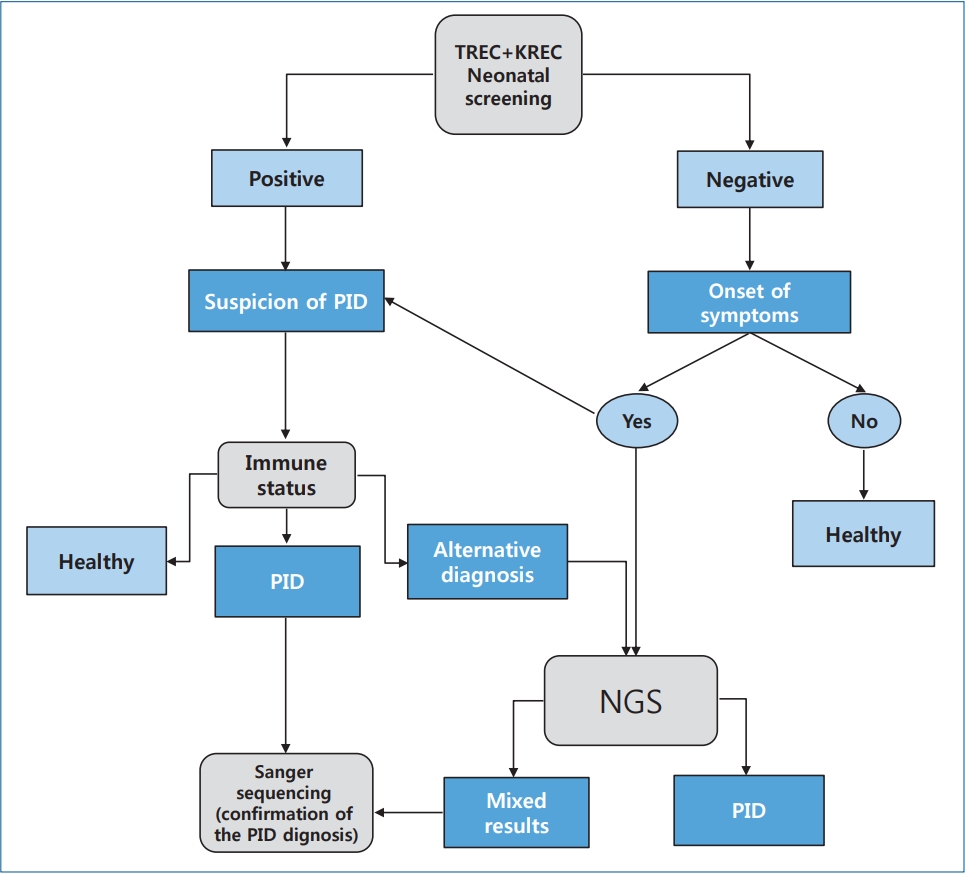
· Neonatal screening for primary immunodeficiency diseases (PIDs) enables early diagnosis and subsequent initiation of therapy.
· Excision of T-cell receptors and kappa-recombination excision circles are cheaper alternative PID screening methods.
· Sanger DNA sequencing remains the reference method for detecting PID; however, next-generation sequencing technology is increasingly used to diagnose it.
· Here we developed a graphical algorithm for diagnosing primary immunodeficiency syndrome based on modern methods of screening for primary immunodeficiencies in newborns.
- General Pediatrics
- Clinical features, diagnosis, and outcomes of multisystem inflammatory syndrome in children associated with coronavirus disease 2019
- Ji Hee Kwak, Soo-Young Lee, Jong-Woon Choi; the Korean Society of Kawasaki Disease
- Clin Exp Pediatr. 2021;64(2):68-75. Published online December 30, 2020
-

Hundreds of cases of children and adolescents with hyperinflammatory responses such as Kawasaki disease have been reported amid the coronavirus disease 2019 (COVID-19) pandemic, leading to coining of the new term COVID-19–associated multisystem inflammatory syndrome in children. In this review article, we introduce the illness and describe its case definitions, epidemiology, pathogenesis, clinical features, treatments, and outcomes.
- Original Article
- Nephrology (Genitourinary)
- Expression profiling of cultured podocytes exposed to nephrotic plasma reveals intrinsic molecular signatures of nephrotic syndrome
- Stuti Panigrahi, Varsha Chhotusing Pardeshi, Karthikeyan Chandrasekaran, Karthik Neelakandan, Hari PS, Anil Vasudevan
- Clin Exp Pediatr. 2021;64(7):355-363. Published online November 1, 2020
-

Question: Is it possible to classify nephrotic syndrome (NS) through gene expression profiling of podocytes exposed to NS plasma?
Finding: Our data showed different expression profiles in podocytes exposed to nephrotic plasma from different clinical groups, suggesting the molecular stratification of patients into intrinsic subtypes.
Meaning: Transcriptome profiling of podocytes treated with NS plasma can stratify patients into intrinsic subtypes and provide insight into the molecular mechanisms of podocyte injury.
- Review Article
- Hematology
- Genetic classification and confirmation of inherited platelet disorders: current status in Korea
- Ye Jee Shim
- Clin Exp Pediatr. 2020;63(3):79-87. Published online February 6, 2020
-
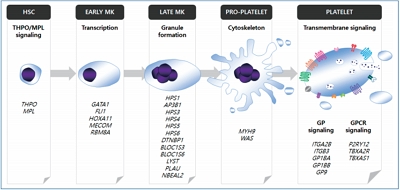
Inherited platelet disorders (IPDs), which manifest as primary hemostasis defects, often underlie abnormal bleeding and a family history of thrombocytopenia, bone marrow failure, hematologic malignancies, undefined mucocutaneous bleeding disorder, or congenital bony defects. Wide heterogeneity in IPD types with regard to the presence or absence of thrombocytopenia, platelet dysfunction, bone marrow failure, and dysmegakaryopoiesis is observed in patients. The individual...
- Original Article
- General Pediatrics
- Prevalence of hyperuricemia and its association with metabolic syndrome and cardiometabolic risk factors in Korean children and adolescents: analysis based on the 2016–2017 Korea National Health and Nutrition Examination Survey
- Jung Hyun Lee
- Clin Exp Pediatr. 2019;62(8):317-323. Published online June 24, 2019
-
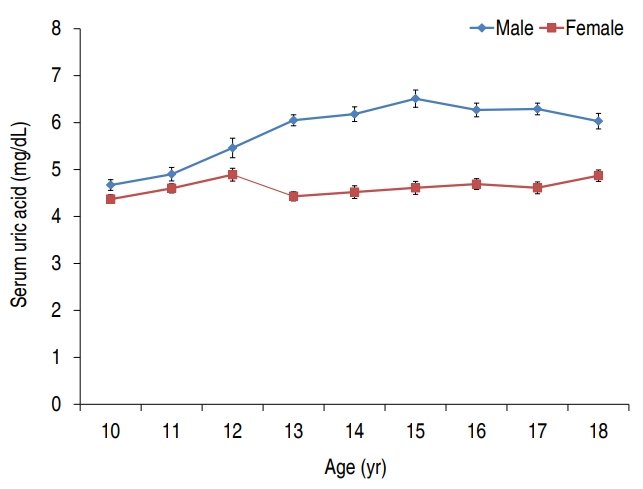
Purpose: Investigating the prevalence of hyperuricemia and its association with metabolic syndrome (MetS) and cardiometabolic risk factors (CMRFs) in Korean children and adolescents. Methods: This cross-sectional survey used data from the 7th Korea National Health and Nutrition Examination Survey (2016–2017); 1,256 males and females aged 10–18 years were included. Hyperuricemia was defined as serum uric acid levels were >6.6 mg/dL at...
- Review Article
- Neonatology (Perinatology)
- Surfactant preparations for preterm infants with respiratory distress syndrome: past, present, and future
- Ga Won Jeon
- Clin Exp Pediatr. 2019;62(5):155-161. Published online February 8, 2019
-

Following the first successful trial of surfactant replacement therapy for preterm infants with respiratory distress syndrome (RDS) by Fujiwara in 1980, several animal-derived natural surfactants and synthetic surfactants have been developed. Synthetic surfactants were designed to overcome limitations of natural surfactants such as cost, immune reactions, and infections elicited by animal proteins contained in natural surfactants. However, first-generation synthetic surfactants...
- Original Article
- Endocrinology
- Comparison of effectiveness of growth hormone therapy according to disease-causing genes in children with Noonan syndrome
- Kyo Jin Jo, Yoo Mi Kim, Ju Young Yoon, Yeoun Joo Lee, Young Mi Han, Han-Wook Yoo, Hyang-Sook Kim, Chong Kun Cheon
- Clin Exp Pediatr. 2019;62(7):274-280. Published online December 3, 2018
-
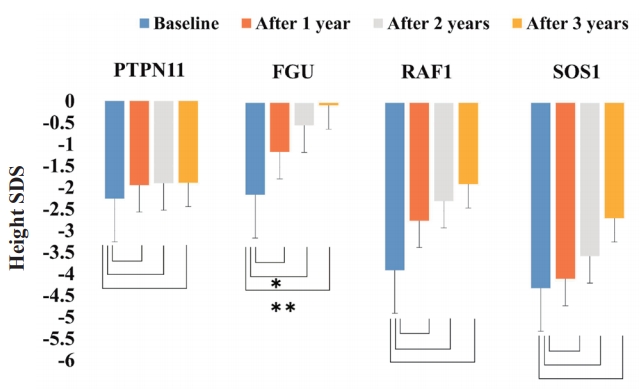
Purpose: To analyze the growth response to growth hormone (GH) therapy in prepubertal patients with Noonan syndrome (NS) harboring different genetic mutations. Methods: Twenty-three patients with prepubertal NS treated at Pusan National University Children’s Hospital between March 2009 and July 2017 were enrolled. According to the disease-causing genes identified, the patients with NS were divided into 4 groups. Three groups were...
- Case Report
- Nephrology (Genitourinary)
- De novo mutations in COL4A5 identified by whole exome sequencing in 2 girls with Alport syndrome in Korea
- Kyoung Hee Han, Jong Eun Park, Chang-Seok Ki
- Clin Exp Pediatr. 2019;62(5):193-197. Published online November 26, 2018
-

Alport syndrome (ATS) is an inherited glomerular disease caused by mutations in one of the type IV collagen novel chains (α3, α4, and α5). ATS is characterized by persistent microscopic hematuria that starts during infancy, eventually leading to either progressive nephritis or end-stage renal disease. There are 3 known genetic forms of ATS, namely X-linked ATS, autosomal recessive ATS, and...
- Original Article
- Neonatology (Perinatology)
- Association between vitamin D level at birth and respiratory morbidities in very-low-birth-weight infants
- Ian Kim, Sung Shin Kim, Jee In Song, Seock Hwa Yoon, Ga Young Park, Yong-Wha Lee
- Clin Exp Pediatr. 2019;62(5):166-172. Published online October 24, 2018
-
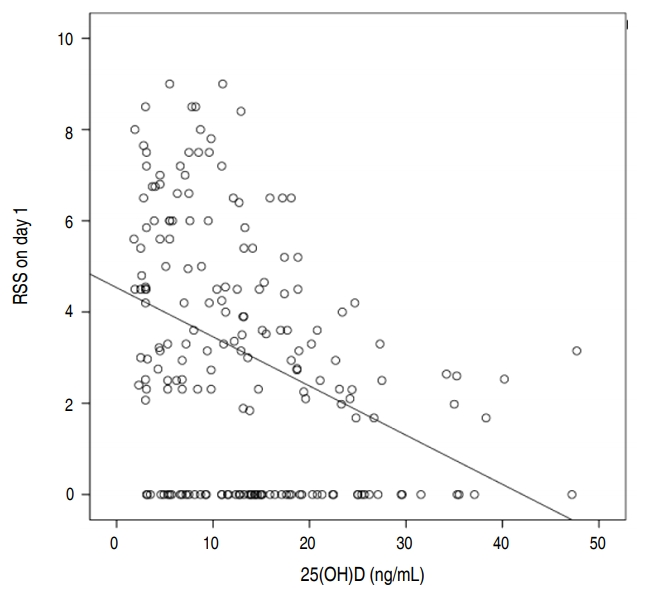
Purpose: This study aimed to evaluate vitamin D status at birth in very-low-birth-weight infants (VLBWIs: <1,500 g) and to determine the association between vitamin D level and respiratory morbidity. Methods: A retrospective study was conducted at Soonchunhyang University Bucheon Hospital between November 2013 and November 2017. We collected blood samples and data on respiratory morbidity from 230 VLBWIs on the first...
- Nephrology (Genitourinary)
- Changes in the thyroid hormone profiles in children with nephrotic syndrome
- Sun Hee Jung, Jeong Eun Lee, Woo Yeong Chung
- Clin Exp Pediatr. 2019;62(3):85-89. Published online October 4, 2018
-

Purpose: We compared thyroid hormone profiles in children with nephrotic syndrome (NS) during the nephrotic phase and after remission. Methods: This study included 31 pediatric NS patients. The thyroid hormone profiles included serum levels of triiodothyronine (T3), thyroxine (T4), thyroid-stimulating hormone (TSH), and free T4. Results: Of the 31 patients, 16 (51.6%) showed abnormal thyroid hormone profiles: 6 had overt hypothyroidism, 8...
- Case Report
- Genetics and Metabolism
- The first Korean case with Floating-Harbor syndrome with a novel SRCAP mutation diagnosed by targeted exome sequencing
- Eun Mi Choi, Dong Hyun Lee, Seok Jin Kang, Ye Jee Shim, Heung Sik Kim, Jun Sik Kim, Jong In Jeong, Jung-Sook Ha, Ja-Hyun Jang
- Clin Exp Pediatr. 2018;61(12):403-406. Published online September 16, 2018
-
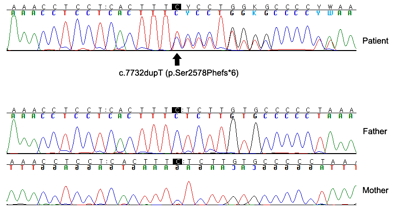
Floating-Harbor syndrome is a rare autosomal dominant genetic disorder associated with SRCAP mutation. To date, approximately 50 cases of Floating-Harbor syndrome have been reported, but none have been reported in Korea yet. Floating-Harbor syndrome is characterized by delayed bony maturation, unique facial features, and language impairment. Here, we present a 6-year-old boy with a triangular face, deep-set protruding eyes, low-set...
- Original Article
- Neonatology (Perinatology)
- Transient intubation for surfactant administration in the treatment of respiratory distress syndrome in extremely premature infants
- Ji Won Koh, Jong-Wan Kim, Young Pyo Chang
- Clin Exp Pediatr. 2018;61(10):315-321. Published online September 16, 2018
-
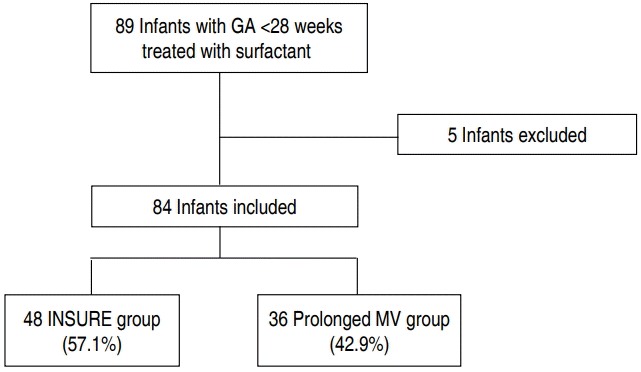
Purpose: To investigate the effectiveness of transient intubation for surfactant administration and extubated to nasal continuous positive pressure (INSURE) for treatment of respiratory distress syndrome (RDS) and to identify the factors associated with INSURE failure in extremely premature infants. Methods: Eighty-four infants with gestational age less than 28 weeks treated with surfactant administration for RDS for 8 years were included. Perinatal...
- Cardiology
- Differentiation between incomplete Kawasaki disease and secondary hemophagocytic lymphohistiocytosis following Kawasaki disease using N-terminal pro-brain natriuretic peptide
- Jung Eun Choi, Yujin Kwak, Jung Won Huh, Eun-Sun Yoo, Kyung-Ha Ryu, Sejung Sohn, Young Mi Hong
- Clin Exp Pediatr. 2018;61(5):167-173. Published online May 28, 2018
-

Purpose Hemophagocytic lymphohistiocytosis (HLH) is a hyperinflammatory syndrome with many causes, including Kawasaki disease (KD). The purpose of this study was to identify the laboratory tests needed to easily differentiate KD with HLH from incomplete KD alone.
Methods We performed a retrospective study on patients diagnosed with incomplete KD and incomplete KD with HLH (HLH-KD) between January 2012 and March 2015. We compared...
- Case Report
- Gastroenterology
- Intestinal duplication revealed by posterior reversible encephalopathy syndrome
- Yosra Kerkeni, Hela Louati, Mourad Hamzaoui
- Clin Exp Pediatr. 2018;61(4):132-134. Published online April 23, 2018
-
We report a unique case of intestinal duplication detected on posterior reversible encephalopathy syndrome (PRES) in a 13-year-old girl. She was admitted to the pediatric Emergency Department because of generalized seizures. Radiological assessment revealed a large, well-defined, thick-walled cystic lesion in the mid abdomen, suggestive of duplication cyst associated to a PRES. Exploration confirmed the diagnosis of ileal duplication cyst,...
- Review Article
- Nephrology (Genitourinary)
- Atypical hemolytic uremic syndrome and eculizumab therapy in children
- Seong Heon Kim, Hye Young Kim, Su Young Kim
- Clin Exp Pediatr. 2018;61(2):37-42. Published online February 28, 2018
-
Hemolytic uremic syndrome (HUS) is often encountered in children with acute kidney injury. Besides the well-known shiga toxin-producing
Escherichia coli -associated HUS, atypical HUS (aHUS) caused by genetic complement dysregulation has been studied recently. aHUS is a rare, chronic, and devastating disorder that progressively damages systemic organs, resulting in stroke, end-stage renal disease, and death. The traditional treatment for aHUS is...
- Original Article
- Cardiology
- Subtle inflammation: a possible mechanism of future cardiovascular risk in obese children
- Watchareewan Sontichai, Prapai Dejkhamron, Peraphan Pothacharoen, Prachya Kongtaweelert, Kevalee Unachak, Nuthapong Ukarapol
- Clin Exp Pediatr. 2017;60(11):359-364. Published online November 27, 2017
-
Purpose The risk of cardiovascular disease (CVD) has been shown to be associated with systemic inflammation in obese adults with metabolic syndrome (MetS). The aims of this study were to evaluate the prevalence of MetS and its relation to inflammatory markers in obese Thai children.
Methods A cross-sectional study was conducted. Children with history of endogenous obesity, chronic diseases, drug ingestion, and any...
- Neurology
- Serum neuron specific enolase is increased in pediatric acute encephalitis syndrome
- Dian Pratamastuti, Prastiya Indra Gunawan, Darto Saharso
- Clin Exp Pediatr. 2017;60(9):302-306. Published online September 21, 2017
-
Purpose This study aimed to investigate whether serum neuron-specific enolase (NSE) was expressed in acute encephalitis syndrome (AES) that causes neuronal damage in children.
Methods This prospective observational study was conducted in the pediatric neurology ward of Soetomo Hospital. Cases of AES with ages ranging from 1 month to 12 years were included. Cases that were categorized as simple and complex febrile seizures...
- Review Article
- Neonatology (Perinatology)
- Update of minimally invasive surfactant therapy
- Gyu-Hong Shim
- Clin Exp Pediatr. 2017;60(9):273-281. Published online September 21, 2017
-

To date, preterm infants with respiratory distress syndrome (RDS) after birth have been managed with a combination of endotracheal intubation, surfactant instillation, and mechanical ventilation. It is now recognized that noninvasive ventilation (NIV) such as nasal continuous positive airway pressure (CPAP) in preterm infants is a reasonable alternative to elective intubation after birth. Recently, a meta-analysis of large controlled trials...
- Original Article
- Cardiology
- Clinical usefulness of serum procalcitonin level in distinguishing between Kawasaki disease and other infections in febrile children
- Na Hyun Lee, Hee Joung Choi, Yeo Hyang Kim
- Clin Exp Pediatr. 2017;60(4):112-117. Published online April 25, 2017
-

Purpose The aims of this study were to compare serum procalcitonin (PCT) levels between febrile children with Kawasaki disease (KD) and those with bacterial or viral infections, and assess the clinical usefulness of PCT level in predicting KD.
Methods Serum PCT levels were examined in febrile pediatric patients admitted between August 2013 and August 2014. The patients were divided into 3 groups as...
-

-
-

-

-
Impact Factor4.2
-
6.52022CiteScore92nd percentilePowered by







